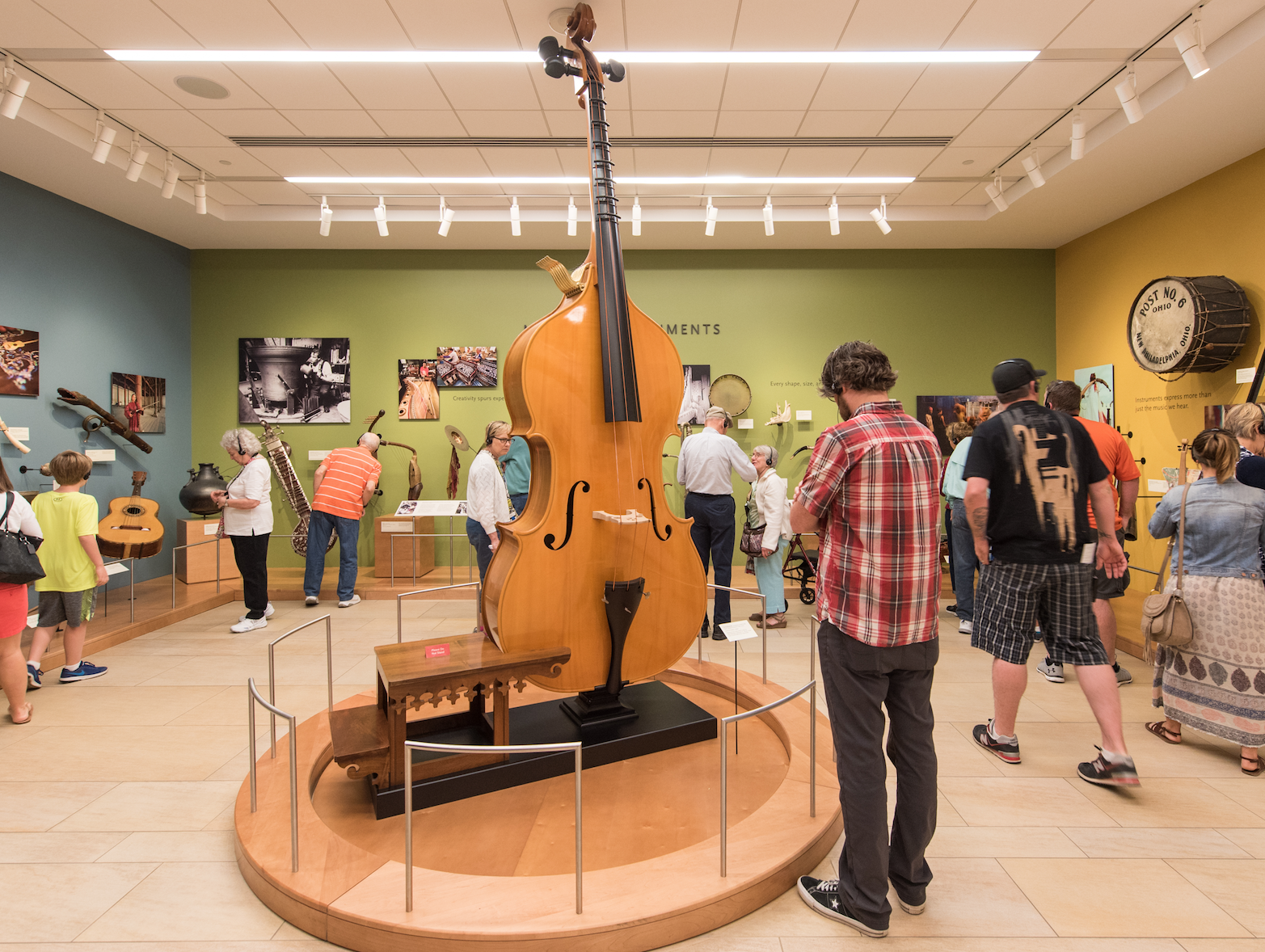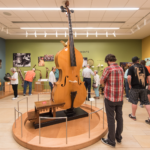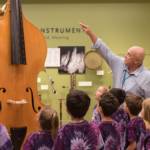Writer Joseph J. Airdo
Photography Courtesy of Musical Instrument Museum
[dropcap]S[/dropcap]trolling through the Orientation Gallery of Phoenix’s Musical Instrument Museum, there is one instrument in particular that is almost impossible to miss. One could even say that it is the elephant in the room: it is nearly as enormous and very rarely discussed.
The octobasse is a sub-bass strings instrument that was invented more than 150 years ago. The 12-foot-tall wonder was designed to create a low-end rumble in symphony orchestras. However, its massive size and challenging operation prevented the instrument from ever truly taking flight. With only seven instruments in existence, observing the octobasse on display at MIM is quite the extraordinary experience.
“It’s just an interesting technological innovation,” said Colin Pearson, MIM’s curator for Asia, Oceania and the Middle East. “It has always been the centerpiece of one of our most prominent galleries, and I think it has become an iconic image for [the museum].”
The Musical Instrument Museum displays more than 6,800 instruments collected from about 200 of the world’s countries and territories. Visitors are offered opportunities to see and hear the instruments, as well as observe them being played in their original contexts during scheduled performances.
“MIM illustrates the cultures from all around the world through music and instruments in a really unique and enjoyable way,” Pearson explained. “The exhibits are deliberately designed to be very accessible and interesting. The variety of places represented, the instruments, and the types of music that people can hear allows them to feel a tremendous sense of discovery.”
The octobasse is a perfect example of such an experience due to its unique size, its extreme rarity and its remarkable potential for teaching its observers some scientific principles that are otherwise difficult to demonstrate. However, perhaps its most fascinating aspect is its origin story.
“It was invented in 1850 in Paris by Jean-Baptiste Vuillaume, who was both a violin maker and a dealer—and extremely influential at that,” said Pearson, noting Vuillaume was also known for his experimental innovations. “He intended for [the octobasse] to be used in particularly large orchestras.”
Vuillaume is said to have collaborated with Hector Berlioz, a famous French composer known for “Symphonie Fantastique” and other elaborate orchestrations. Berlioz’s “Treatise on Instrumentation” mentions the octobasse, and even goes so far as to suggest that every orchestra of 150 people or more have at least three octobasses in their repertoire.
“They wouldn’t play them all the time,” Pearson said. “They would only play them at big, dramatic moments, and they would just play some long, low, sustained notes to add that rumble effect.”
That is perhaps why Vuillaume created three octobasses. But, because of their size, the instruments never quite caught on. And Vuillaume’s three original octobasses were the only ones in existence until recently. Two of the original octobasses—neither of which is playable—are on display in museums in Europe, while the third is said to have been burned in fire at a museum in Russia.
The instrument has since seen a surge in interest, with five playable replicas being built since the 1990s. Antonio Dattis, an Italy-based luthier (maker of stringed instruments), built the octobasse that is on display at MIM in 2007. It has been on display at the museum since its grand opening in 2010.
“It’s a combination of traditional violin-making with a significant amount of innovation and improvisation on the maker’s part,” Pearson said. “A typical double bass would be made with maple and spruce and then ebony for the fingerboard. But those woods are just not available in sizes large enough to make [an octobasse].”
As a result, Dattis used pieces of elm for the body of the instrument. He still used traditional spruce for the instrument’s soundboard, but had to splice together several pieces of it in order to meet the size requirements. Dattis then used ebonized cherry wood for the black fingerboard.
Pearson said the techniques used to play the instrument are similar to those used to play a standard double bass or cello except “a lot more like a wrestling match.”
The MIM curator explained that the octobasse’s big size requires the player to use levers to clamp down on the strings to change notes. Everything about the instrument is heavy and slow, including its bow which requires significant strength to even hold.
“Just pulling the bow across the strings and trying to keep a note going, it almost feels like it’s bucking the bow off, so it takes some real effort just to do that very basic motion,” said Pearson, noting each of the octobasse’s three strings vibrates wildly. “Similarly, when you’re pulling down on the levers to change each note, it requires a lot of extra thought and planning. It takes time. There’s only so fast you can go.”
Unlike Vuillaume’s original octobasse, the replica on display at MIM is built around a steel space frame that strengthens the instrument’s structure and bears much of the tension from its strings. MIM’s replica also features a more responsive system of pulleys and levers built into the neck of the instrument that allows the player to change notes with one hand.
“The pulleys on the original [octobasses] from 1850 were not terribly effective, so it required both pulling down the lever with your hand and using a foot pedal to get more leverage for that clamping effect,” Pearson explained. “That would have made the instrument even slower to operate.”
The octobasse’s lowest note is pitched at 16 hertz. That is below the range of human hearing, which bottoms out at 20 hertz. At those low frequencies, the human ear still picks up certain sounds, called overtones. The rest is a rumble effect that is less heard than felt, similar to a subwoofer in a movie theater.
“It is quite a production to tune,” said Pearson, noting the strings on MIM’s octobasse occasionally stretch and require tuning. “It has tuners down at foot level, but the tuning pegs up at the top are also functional. They do sometimes slip and we have to have someone get on a ladder 12 feet in the air to crank those back up to tension.”
The octobasse can be heard in action during performances by the Montreal Symphony Orchestra, which obtained one of the replicas in 2016. MIM’s octobasse can be heard on the soundtrack for the major motion picture “The Hunger Games,” for which film composer Hans Zimmer visited the Valley and recorded its sound.
In addition to the cultural significance of its history and its contributions to the demonstration of scientific principles, Pearson most appreciates the octobasse for its testament to the inventive spirit of people. He said that creating huge instruments is a source of continual fascination for people.
“People are always experimenting with ways to make instruments bigger or to explore deeper tones with them,” Pearson explained. “People get fascinated with a certain concept and they’ll just keep trying to find ways to achieve that, even if some of those attempts are dead ends. The octobasse is a great example of that fascination from 150 years ago.”
The Octobasse
Daily
9 a.m.–5 p.m.
Musical Instrument Museum
4725 E. Mayo Blvd., Phoenix
$20 admission
480-478-6000
mim.org










Comments by Admin